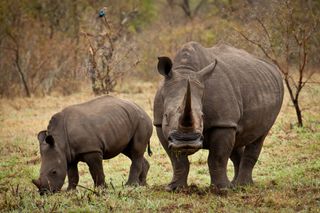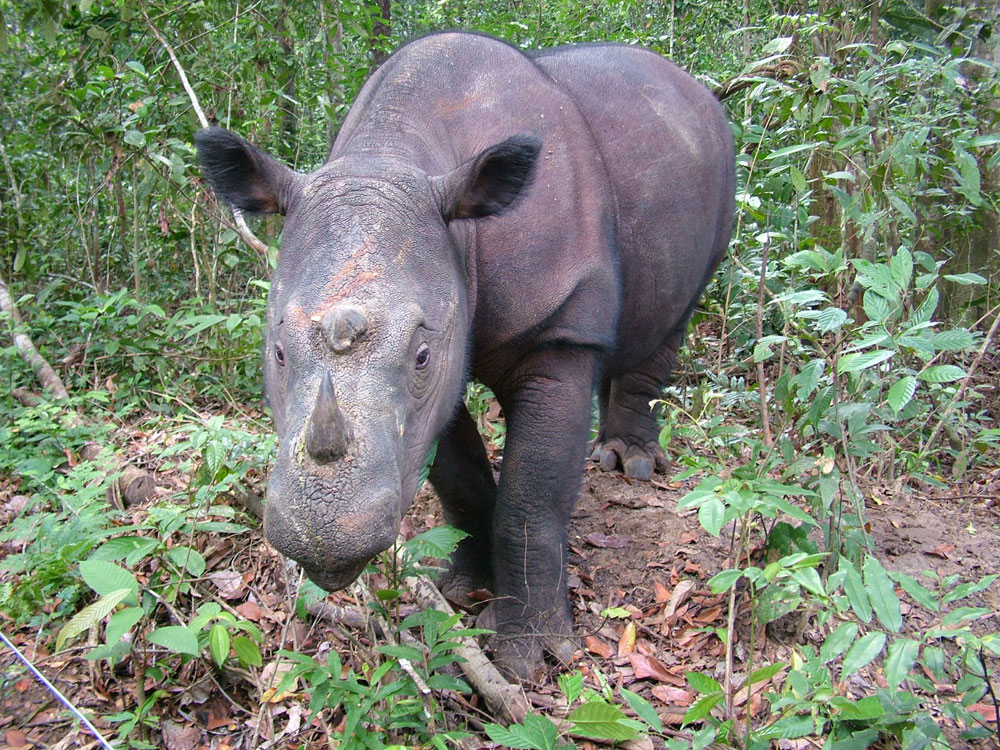Where Does Newborn Baby Rhinos Live Baby Rhino Two Horns
Facts Well-nigh Rhinos

Rhinoceroses are large, herbivorous mammals identified past their characteristic horned snouts. The word "rhinoceros" comes from the Greek "rhino" (nose) and "ceros" (horn). There are five species and 11 subspecies of rhino; some take two horns, while others have one.
Because the animals' horns are used in folk medicine for their supposed healing properties, rhinos have been hunted nearly to extinction. Their horns are sometimes sold as trophies or decorations, but more than frequently they are basis upward and used in traditional Chinese medicine. The powder is often added to food or brewed in a tea in the belief that the horns are a powerful aphrodisiac, a hangover cure and treatment for fever, rheumatism, gout and other disorders, according to the International Rhino Foundation.
Conservation status
Save the Rhino estimates that there were 500,000 rhinos beyond Africa and Asia at the beginning of the 20th century. Today, the grouping says, in that location are 29,000 rhinos in the wild. Poaching and loss of habitat have put all rhinoceros species in danger of extinction. [Related: 2013 Was Record Twelvemonth for Rhino Poaching in Southward Africa]
Co-ordinate to International Union for Conservation of Nature's Ruby-red List of Threatened Species:

- Black rhinos, Sumatran rhinos and Javan rhinos are "critically endangered," which is the list's highest run a risk category. There are five,055 black rhinos, fewer than 100 Sumatran rhinos and just 35 to 44 Javan rhinos. [Related: Javan Rhino Officially Extinct in Vietnam]
- Greater i-horned rhinos are "vulnerable," which means they may become endangered unless circumstances meliorate. Fortunately, their population is increasing; at that place are 3,333 greater one-horned rhinos in the world. The total population estimate in 2007 was two,575 individuals, according to the IUCN.
- White rhinos are "near threatened," which means they may be considered threatened past extinction in the nigh future. Southern white rhinos have an increasing population; there are 20,405 southern white rhinos. However, the northern white rhino is considered "extinct" in the wild.
In 2009, 4 northern white rhinos were moved from a zoo in the Czech Commonwealth to a private conservancy in Republic of kenya in the hope that they would brood, according to the IUCN. On Oct. 18, 2014, Ol Pejeta Salvation announced that one of them, ane of the terminal two breeding males, had died. He was not a victim of poaching, notwithstanding, and the conservancy was investigating the cause of death. On March 20, 2018, the conservancy announced the decease of the terminal male northern white rhino, Sudan.
There are now only two northern white rhinos left in the world, both living in captivity, according to the World Wild animals Fund. The captive northern white rhinos are two females — Najin, Sudan'southward daughter, and Fatu, Najin's daughter — which live in the Ol Pejeta Salvation in Republic of kenya. The two females are incapable of a successful pregnancy: Najin is too sometime and bug with her legs make information technology incommunicable for her to support the weight of a mounting male; Fatu has a uterine condition that will likely proceed her from breeding, according to experts.
With natural convenance attempts nixed for the northern white rhinos, conservationists take turned to in vitro fertilization. However, IVF in these rhinoceroses comes with its own set of challenges, including figuring out how to go immature eggs to develop outside of the female's body and also how to inject sperm into these eggs.
As for the Sumatran rhinos, they are hanging on by a thread as well. Along with the Javan rhino, Sumatran rhinos are barely hanging on in the wild. They went extinct in Vietnam in 2010 and in Malaysia in 2015, according to the International Rhino Foundation. Small populations of the subspecies survive in 3 national parks in Sumatra. And in March 2016, conservationists captured a alive Sumatran rhinoceros in the Indonesian function of the island of Borneo for the first time. Though a camera-trap image snapped in 2013 revealed Sumatran rhinos did survive in this region called Kalimantan, the capture of the female marked the first time in twoscore years that humans had physically contacted a alive Sumatran rhino at that place.
Rhino horns
Rhino horns are fabricated of keratin, which is besides the key component of human hair and fingernails. Simply the horns are non but dumbo clumps of hair. CT scans have shown dense mineral deposits of calcium and melanin in the core of the horn. The calcium makes the horn stronger, and the melanin protects it from the sun'due south UV rays, according to scientists at Ohio University.
The horns are similar to horse hooves, turtle beaks and cockatoo bills, said Tobin Hieronymus, an OU doctoral pupil. Rhinoceros horns tend to curve backward, toward the head, because the keratin in front grows faster than the keratin in the dorsum, Hieronymus told Live Science. The outside of the horn is rather soft and can be worn down or sharpened after years of use, co-ordinate to the San Diego Zoo. If a horn breaks off, it can gradually grow back.
Black rhinos, white rhinos and Sumatran rhinos have ii horns. Javan rhinos and greater one-horned rhinos accept 1. On the black rhino, the forepart horn tin can grow to 20 to 51 inches (51 to 130 centimeters), while the rear horn tin grow to most twenty inches, co-ordinate to the International Rhino Foundation. A white rhino's horns are slightly smaller, and a Sumatran rhinos horns are about 10 to 31 inches (25 to 79 cm) for the front and less than three inches (7 cm) for the rear. The greater 1-horned rhino'south horn is viii to 24 inches (xx to 61 cm), and Javan rhinos have a horn that is near 10 inches (25 cm) long.
How big are rhinos?
The largest rhino species is the white rhino, co-ordinate to the San Diego Zoo. It grows to 12 to 13 feet (3.seven to iv meters) long and upwardly to 6 anxiety (ane.8 m) from hoof to shoulder. It weighs around 5,000 lbs. (ii,300 kilograms).
The smallest rhinoceros species is the Sumatran rhino. It grows to 8 to 10 feet (ii.5 to 3 yard) long and upwardly to 4.8 feet (1.5 m) from hoof to shoulder. The Sumatran rhino weighs effectually one,765 lbs. (800 kg).
Habitat
White rhinos and black rhinos live in the grasslands and floodplains of eastern and southern Africa. Greater i-horned rhinos can be found in the swamps and rain forests of northern India and southern Nepal. Sumatran and Javan rhinos are institute merely in small areas of Malaysian and Indonesian swamps and rain forests.
Rhinos spend their days and nights grazing and simply sleep during the hottest parts of the day. During the rare times when they aren't eating, they tin be found enjoying a cooling mud soak. These soaks also aid to protect the animals from bugs, and the mud is a natural sunblock, according to National Geographic.
Though rhinos are frequently solitary, they do occasionally form groups. Chosen crashes, these groups are made up of a female and her offspring. A dominant male rules over an expanse of land. The male will allow some sub-dominate males to live on his territory. Females roam freely around several different territories.
Diet
Rhinoceroses are herbivores, which means they eat only vegetation. The type of vegetation they eat varies by species. This is because their snouts are unlike shapes to accommodate dissimilar types of nutrient, according to National Geographic. For example, the black rhino eats trees or bushes because its long lips permit it to pick leaves and fruit from up high. The white rhino has a apartment-shaped snout that lets it get closer to the ground for eating grass.
Offspring
Every ii and a half to five years, a female person rhino will reproduce. Female rhinos carry their young for a gestation menstruation of 15 to sixteen months. They usually merely have i babe at a time, though they do sometimes take twins. At birth, babe rhinos, which are called calves, are still quite big, at 88 to 140 lbs. (forty to 64 kg), according to the San Diego Zoo.
At around iii years old, the calf will fix out on its ain. A rhino can alive upwards to 45 years.
Nomenclature/taxonomy
According to the Integrated Taxonomic Information System (ITIS), the taxonomy of rhinos is:
Kingdom: Animalia Subkingdom: Bilateria Infrakingdom: Deuterostomia Phylum: Chordata Subphylum: Vertebrata Infraphylum: Gnathostomata Superclass: Tetrapoda Class: Mammalia Bracket: Theria Infraclass: Eutheria Gild: Perissodactyla Family: Rhinocerotidae Genera & species:
- White rhinos: Ceratotherium simum (southern white rhinoceros), Ceratotherium cottoni (northern white rhinoceros). IUCN lists these as subspecies of Ceratotherium simum.
- Sumatran rhinos: Dicerorhinus sumatrensis (also called hairy rhinoceros, Asian two-horned rhino). Subspecies: Dicerorhinus sumatrensis harrisoni, Dicerorhinus sumatrensis lasiotis, Dicerorhinus sumatrensis sumatransis
- Blackness rhinos: Diceros bicornis (black rhinoceros).Subspecies: Diceros bicornis bicornis, Diceros bicornis brucii, Diceros bicornis chobiensis, Diceros bicornis ladoensis, Diceros bicornis longipes, Diceros bicornis michaeli, Diceros bicornis minor, Diceros bicornis occidentalis
- Javan rhinos: Rhinoceros unicornis
- Greater one-horned rhinos: Rhinoceros sondaicus (also called Indian rhinoceros). Subspecies: Rhino sondaicus annamiticus, Rhinoceros sondaicus inermis, Rhinoceros sondaicus sondaicus
Other facts

Though rhinos don't oft hang out with each other, they practise hang out with birds. The oxpecker will sit on a rhinoceros'due south dorsum and eat the bugs that crawl on the rhino's peel. That's non the only thing this bird is good for. When danger approaches, the bird will call out, warning the rhino.
When rhinos are happy, they make a loud "mmwonk" sound with their mouths.
Black rhinos are non actually black, according to the International Rhinoceros Foundation. They probably got that proper name from the dark, muddy soil they similar to wallow in or to distinguish them from white rhinos.
Poachers also value rhino horns for making ornamental dagger handles chosen jambiyas, according to Relieve the Rhino. This type of handle became a status symbol in Yemen in the 1970s and '80s, fueled past the oil boom, when more people could afford luxury items. Jambiyas can be made from precious metal, buffalo hibernate or plastic, but those made from rhino horn were considered the "Rolex" version. Salve the Rhino reports that this use of rhino horn has accounted for fewer poaching incidents in contempo years.
The woolly rhino died out about x,000 years ago. Fossils accept been discovered throughout Europe and Asia, according to the International Rhinoceros Foundation. Early humans hunted these animals, and they were depicted in paintings on cave walls in France 30,000 years agone.
Additional resource
- International Rhino Foundation
- Save the Rhinoceros
- Ol Pejeta Conservancy
Source: https://www.livescience.com/27439-rhinos.html

0 Response to "Where Does Newborn Baby Rhinos Live Baby Rhino Two Horns"
Post a Comment